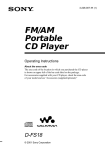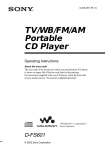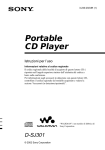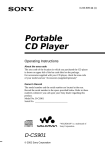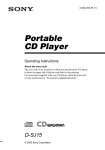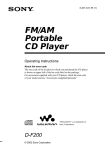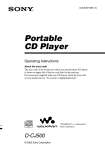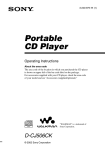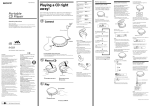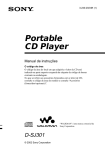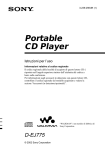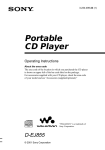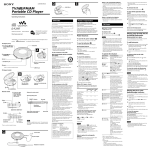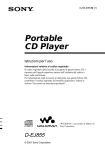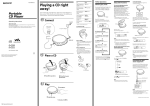Download Portable CD Player
Transcript
3-240-202-21 (1) Portable CD Player Operating Instructions About the area code The area code of the location in which you purchased the CD player is shown on upper left of the bar code label on the package. For accessories supplied with your CD player, check the area code of your model and see “Accessories (supplied/optional).” “WALKMAN” is a trademark of Sony Corporation. D-SJ301 © 2002 Sony Corporation WARNING To prevent fire or shock hazard, do not expose the unit to rain or moisture. Do not install the appliance in a confined space, such as a bookcase or built-in cabinet. To prevent fire, do not cover the ventilation of the apparatus with newspapers, tablecloths, curtains, etc. And don’t place lighted candles on the apparatus. To prevent fire or shock hazard, do not place objects filled with liquids, such as vases, on the apparatus. CAUTION The use of optical instruments with this product will increase eye hazard. Certain countries may regulate disposal of the battery used to power this product. Please consult with your local authority. CAUTION • INVISIBLE LASER RADIATION WHEN OPEN • DO NOT STARE INTO BEAM OR VIEW DIRECTLY WITH OPTICAL INSTRUMENTS The CE mark is valid only for products marketed in the European Union. For the customers in Australia The supply cord of the AC power adaptor cannot be replaced; if the cord is damaged, the AC power adaptor should be discarded. 2 Table of Contents Getting started Locating the controls ................................... 4 Playing a CD 1. Connect your CD player. ......................... 6 2. Insert a CD. ............................................. 6 3. Play a CD. ............................................... 7 Playback options Playing tracks repeatedly (Repeat play) .... 10 Playing a single track (Single play) ........... 10 Playing tracks in random order (Shuffle play) ......................................... 10 Playing tracks in your favorite order (PGM play) ............................................ 11 Connecting to a power source Using the rechargeable batteries ................ 16 Using dry batteries ..................................... 18 Notes on the power source ........................ 18 Additional information Precautions ................................................ 19 Maintenance .............................................. 20 Troubleshooting ......................................... 21 Specifications ............................................ 23 Accessories (supplied/optional) .. Back cover Available features G-PROTECTION function ........................ 12 Emphasizing the bass sound (SOUND) .... 12 Protecting your hearing (AVLS) ................ 13 Locking the controls (HOLD) ................... 13 Turning off the operation beep sound ........ 14 Connecting your CD player Connecting a stereo system ....................... 15 3 Getting started Locating the controls For details, see pages in parentheses. CD player (front) 1 HOLD switch (page 13) 6 PLAY MODE button (pages 9 - 11) 2 3-way control key (see below) 7 REPEAT/ENTER button (pages 9 - 11) 3 VOL (volume) control (page 7) 8 SOUND button (pages, 12, 13) 9 i (headphones) jack (pages 6, 15) 4 DC IN 4.5 V (external power input) jack (pages 6, 16) 5 Display (pages 8, 10 - 13) q; Buckle 2 3-way control key N/>: Play/AMS/search (pages 6, 7, 11) .: AMS/search (pages 7, 11) x/CHG: stop/charge (pages 7, 14, 16) Push toward N/> or .. 4 Press x/CHG. CD player (inside) Getting started qa G-PROTECTION switch (page 12) qs Battery compartment (page 16) Using the hand strap While jogging, use the supplied hand strap. 1 Pass the strap through the hooks. 2 Put your hand between the player and the strap, then adjust the length of the strap and fix it using the Velcro tapes. 5 Playing a CD You can also use rechargeable batteries and dry batteries as a power source. 1. Connect your CD player. 1 Connect the AC power adaptor. 2 Connect the headphones/earphones. to an AC outlet AC power adaptor 3-way control key (N/>) to i (headphones) Headphones or Earphones to DC IN 4.5V 2. Insert a CD. 1 Unfasten the buckle. 2 Open the lid. 3 Fit the CD on the pivot and close the lid. 4 While holding the lid closed, fasten the buckle securely. Label side up 6 3. Play a CD. To Play (from the point you stopped) Play (from the first track) Stop Find the beginning of the current track (AMS*1) Find the beginning of the previous tracks (AMS) Find the beginning of the next track (AMS) Find the beginning of the succeeding tracks (AMS) Go backwards quickly Go forward quickly Playing a CD Push the 3-way control key toward N/>. Adjust the volume. Do this Push the 3- way control key toward N/>. Playback starts from the point you stopped. Push the control key toward N/> and hold it for 2 seconds or more. Press x/CHG*2 Push the control key toward .once quickly*2 Push the control key toward . repeatedly*2, *3 Push the control key toward N/> once quickly*2, *3 Push the control key toward N/> repeatedly*2, *3 Push the control key toward . and hold it*2 Push the control key toward N/> and hold it*2 *1 Automatic Music Sensor *2 These operations can be done during play. *3 After you have played the last track, you can return to the beginning of the first track by pushing the 3- way control key toward N/> . Similarly, if you are at the first track, you can locate the last track by pushing the control key toward .. (Continued) 7 About the display • When you push the 3- way control key toward N/> after changing the CD or turning off and on the player, the total number of tracks in the CD and total playing time appear for about two seconds. • During play, the track number and the elapsed playing time of the current track appear. If the volume level does not increase If “AVLS” appears in the display, hold down SOUND until “AVLS ” disappears from the display. For details, see “Protecting your hearing (AVLS).” About CD-Rs/CD-RWs This CD player can play CD-Rs/CD-RWs recorded in the CD-DA format*, but playback capability may vary depending on the quality of the disc and the condition of the recording device. * CD-DA is the abbreviation for Compact Disc Digital Audio. It is a recording standard used for the Audio CDs. Removing the CD Remove the CD while pressing the pivot in the center of the tray. 8 Playback options You can enjoy various ways of playback using PLAY MODE and REPEAT/ENTER. PLAY MODE button Each time you press the button, you can change the playback mode. No indication (Normal play) REPEAT/ENTER button “SHUF” (Play tracks in random order) “PGM” (Play tracks in your favorite order) REPEAT You can repeat play that is selected using PLAY MODE. ENTER You can select tracks for PGM play mode. 3- way control key (N/>, .) (Continued) 9 Playback options “1” (Play a single track) Playing tracks repeatedly (Repeat play) You can play tracks repeatedly in normal, single, shuffle and PGM play modes. During playback, press REPEAT/ENTER. Playing a single track (Single play) During playback, press PLAY MODE repeatedly until “1” appears. Playing tracks in random order During playback, press PLAY MODE repeatedly until “SHUF” appears. 10 (Shuffle play) Playing tracks in your favorite order (PGM play) You can program the CD player to play up to 64 tracks in your favorite order. 1 During playback, press PLAY MODE repeatedly until “PGM” appears. 2 Push the 3-way control key toward . or N/> to select a track. Track number Playback options Playing order 3 Press REPEAT/ENTER to enter the selected track. “00” appears and the playing order increases by one. 4 5 Repeat steps 2 and 3 to select the tracks in your favorite order. Hold down REPEAT/ENTER to start PGM play. To check the program During programming: Press REPEAT/ENTER repeatedly before step 5. During the PGM play: Press PLAY MODE repeatedly until “PGM” flashes, then press REPEAT/ENTER. Each time you press REPEAT/ENTER, the track number appears. Notes • When you finish entering the 64th track in step 3, the first selected track appears in the display. • If you select more than 64 tracks, the first selected tracks are erased. 11 B Available features G-PROTECTION function Emphasizing the bass sound (SOUND) The G-PROTECTION function has been developed to provide excellent protection against sound skipping while jogging. When you set the G-PROTECTION switch on your CD player to “2”, the GPROTECTION function will be enhanced compared to “1.” To walk with the CD player and enjoy high quality CD sound using the G-PROTECTION function, set the G-PROTECTION switch to “1.” While taking harder exercise, it is recommended that you set it to “2.” . You can emphasize the bass-boosted sound. Press SOUND to select “BASS “BASS .” ” or No indication (Normal play) BASS BASS Set G-PROTECTION (under the lid) to “1” or “2.” The selected sound mode is displayed. During active uses, use the supplied hand strap (see “Using the supplied hand strap” in Locating the controls). “BASS ” enhances the bass sound more than “BASS .” Note Note Sound may skip: – if the CD player receives stronger continuous shock than expected, – if a dirty or scratched CD is played or – when using poor-quality CD-Rs/CD-RWs or if there is a problem with the original recording device or application software. 12 If the sound is distorted when using the SOUND function, turn down the volume. Protecting your hearing Locking the controls (AVLS) (HOLD) The AVLS (Automatic Volume Limiter System) function keeps down the maximum volume to protect your hearing. You can lock the controls on your CD player to prevent accidental button presses. Hold down SOUND until “AVLS” appears in the display. Slide HOLD in the direction of the arrow. To turn off the AVLS function Hold down SOUND until “AVLS” disappears from the display. Available features Displayed when AVLS function is activated. Displayed when the HOLD function is activated. Note If you use the SOUND function and the AVLS function at the same time, sound may be distorted. If this happens, turn down the volume. To unlock the controls Slide HOLD in the opposite direction of the arrow. 13 Turning off the operation beep sound You can turn off the beep sound that is heard from your headphones/earphones when you operate your CD player. 1 Remove the power source (AC power adaptor, rechargeable batteries or dry batteries) from the CD player. 2 Connect the power source while pressing x/CHG. To turn on the beep sound Remove the power source and then connect the power source without pressing x/CHG. 14 B Connecting your CD player Connecting a stereo system You can listen to CDs through a stereo system and record CDs on a cassette tape. For details, see the instruction manual that comes with the connected device. Be sure to turn off all connected devices before making connections. Notes • Before you play a CD, turn down the volume of the connected device to avoid damaging the connected speakers. • Use the AC power adaptor for recording. If you use the rechargeable batteries or dry batteries as a power source, batteries may become completely depleted during recording. • Adjust the volume properly on the CD player and connected device so that the sound will not be distorted or noisy. About the G-PROTECTION function when using the connecting cord To record high quality CD sound, set the G-PROTECTION switch to “1.” to i Adjust the volume. Connecting your CD player Connecting cord Right (red) Left (white) Stereo system, cassette recorder, radio cassette recorder, etc. 15 B Connecting to a power source You can use the following power sources: • Rechargeable batteries • AC power adaptor (see “Playing a CD”) • LR6 (size AA) alkaline batteries 3 Connect the AC power adaptor to the DC IN 4.5 V jack of your CD player and an AC outlet, then press x/CHG to start charging. For the battery life and charging time of the rechargeable batteries, see “Specifications.” Using the rechargeable batteries Charge the rechargeable batteries before using them for the first time. You can use only the following rechargeable batteries for your CD player. • NH-WM2AA (NH-WMAA × 2) 1 to DC IN 4.5 V 3-way control key (x/CHG) Open the battery compartment lid inside your CD player. AC power adaptor to an AC outlet 2 Insert two rechargeable batteries by matching the 3 to the diagram in the battery compartment and close the lid until it clicks into place. Insert the # end first (for both batteries). 16 The CD player charges the batteries. The “CHG” indicator turns on in the display, and the indicator sections of light up in succession. When the batteries are completely charged, the “CHG” and indicators turn off. If you press x/CHG after the charge has already been completed, the indicator flashes and “Full” appears in the display. 4 Disconnect the AC power adaptor. To remove the rechargeable batteries Remove the batteries as illustrated below. When to replace the rechargeable batteries If the battery life becomes shorter by about half, replace the batteries with new rechargeable batteries. Note on the rechargeable batteries If the battery is new or has not been used for a long time, it may not be charged completely until you charge and discharge it several times. When to charge the rechargeable batteries You can check the remaining power of the batteries in the display. Battery power is full. ○ ○ ○ r Note on carrying the rechargeable batteries Use the supplied battery carrying case to prevent unexpected heat. If the rechargeable batteries and the metallic objects are contacted, heat or fire may occur due to a short circuit. ○ r ○ Battery power is getting low. ○ ○ r To attach the battery compartment lid If the battery compartment lid is detached by an accidental drop, excessive force, etc., attach it as illustrated below. ○ ○ r Lo batt* Connecting to a power source Battery power is low. r Batteries are depleted. * Beep sounds. To keep the original battery capacity for a long time, charge the batteries only when they are completely depleted. Notes • The indicator sections of roughly show the remaining battery power. One section does not always indicate one-fourth of the battery power. • Depending on operating conditions, the indicator sections of may increase or decrease. 17 Using dry batteries Use only the following dry battery type for your CD player: • LR6 (size AA) alkaline batteries Note Be sure to remove the AC power adaptor when using the dry batteries. 1 Open the battery compartment lid. 2 Insert two LR6 (size AA) batteries by matching the 3 to the diagram in the battery compartment. Insert the # end first (for both batteries). To remove the batteries Remove the batteries in the same way as rechargeable batteries. When to replace the batteries You can check the remaining power of the batteries in the display. Battery power is full. ○ ○ ○ r ○ r Battery power is getting low. ○ ○ ○ r ○ ○ r Battery power is low. r Lo batt* Batteries are depleted. * Beep sounds. When the batteries are depleted, replace both batteries with new ones. 18 Notes on the power source Disconnect all power sources when the CD player is not used. On AC power adaptor • Use only the AC power adaptor supplied or recommended in “Accessories (supplied/ optional).” Do not use any other AC power adaptor. It may cause a malfunction. Polarity of the plug • When disconnecting the AC power adaptor from the AC outlet, grasp the adaptor itself. Do not pull it by the cord. • Do not touch the AC power adaptor with wet hands. On rechargeable batteries and dry batteries • Do not charge the dry batteries. • Do not throw the batteries into fire. • Do not carry the batteries with coins or other metallic objects. It can generate heat if the positive and negative terminals of the battery are accidentally contacted by a metallic object. • Do not mix rechargeable batteries with dry batteries. • Do not mix new batteries with old ones. • Do not use different types of batteries together. • When the batteries are not to be used for a long time, remove them. • If battery leakage occurs, wipe off any deposit in the battery compartment, and install new batteries. In case the deposit adheres to you, wash it off thoroughly. B Additional information Precautions On safety • Should any solid objects or liquid fall into the CD player, unplug it and have it checked by qualified personnel before operating it any further. • Do not put any foreign objects in the DC IN 4.5 V (external power input) jack. On the CD player On handling CDs • To keep the CD clean, handle it by its edge. Do not touch the surface. • Do not stick paper or tape onto the CD. Not these ways On headphones/earphones Road safety Do not use headphones/earphones while driving, cycling, or operating any motorized vehicle. It may create a traffic hazard and is illegal in some areas. It can also be potentially dangerous to play your headsets at high volume while walking, especially at pedestrian crossings. You should exercise extreme caution or discontinue use in potentially hazardous situations. Preventing hearing damage Avoid using headphones/earphones at high volume. Hearing experts advise against continuous, loud and extended play. If you experience a ringing in your ears, reduce volume or discontinue use. Consideration for others Keep the volume at a moderate level. This will allow you to hear outside sounds and to be considerate to the people around you. On the water resistance • Before unfastening the buckle to open the lid, be sure to wipe off water, dust or sand on the exterior of the unit. Open and close the lid where water or sand cannot fall in the unit, and make sure that your hands are dry. If water or sand falls in the unit, trouble may occur. • When closing the lid, check that there is no dust or sand on the rubber packing around the lid. Then close the lid firmly with the buckle. (Continued) 19 Additional information • Keep the lens on the CD player clean and do not touch it. If you do so, the lens may be damaged and the CD player will not operate properly. • Do not put any heavy object on top of the CD player. The CD player and the CD may be damaged. • Do not leave the CD player in a location near heat sources, or in a place subject to direct sunlight, excessive dust or sand, moisture, rain, mechanical shock, unleveled surface, or in a car with its windows closed. • If the CD player causes interference to the radio or television reception, turn off the CD player or move it away from the radio or television. • Discs with non-standard shapes (e.g., heart, square, star) cannot be played on this CD player. Attempting to do so may damage the CD player. Do not use such discs. • Do not expose the CD to direct sunlight or heat sources such as hot air ducts. Do not leave the CD in a car parked under direct sunlight. • Do not use the CD soiled with dust. Malfunction may occur. Precautions Maintenance • The supplied headphones are not meant to be immersed in water or come in continuous contact with water. If they are accidentally dropped into water or get wet, dry them with a soft cloth. Never use an electric hair dryer. • The supplied AC power adaptor is not water resistant. To prevent shock hazard, avoid using the player near water during AC operation. • Cover the DC IN 4.5 V jack and i jack with the attached rubber caps when nothing is connected to these jacks. If the inside of the jacks are contaminated with water or sand, rust may develop and cause trouble. To clean the casing Notes • Since the unit is airtight, you may not be able to open the lid when there is a sudden change in air pressure inside the unit. This happens when the unit is transported on a plane or moved from a warm place to a cold place. In this case, open the rubber cap on the DC IN 4.5 V jack. • To prevent water from leaking in, the buckle is designed to be slightly stiff. Be careful not to catch a fingernail on the buckle when unfastening the lid. Do not hold the player with the buckle by itself. Doing so may damage the unit. 20 Use a soft cloth slightly moistened in water or a mild detergent solution. Do not use alcohol, benzine or thinner. To clean the headphones/ earphones plug Keep the plug of your headphones/earphones clean to obtain optimum sound. Wipe it with a dry, soft cloth. To remove any dust or sand from the rubber packing Any sand or dust on the rubber packing will prevent the lid from shutting tightly, and water may leak in. Brush off the dust once in a while. We recommend the replacement of the rubber packing every year which is available optionally at an authorized Sony service facility. Troubleshooting Should any problem persist after you have checked these symptoms, consult your nearest Sony dealer. Symptom Cause and/or corrective actions The volume does not increase even if the VOL control is adjusted to the maximum level. No sound, or noise is heard. c If “AVLS” appears in the display, hold down SOUND until “AVLS” disappears from the display. (page 13) The playing time is too short when powered with the dry batteries. The playing time is too short when powered with the rechargeable batteries. “Lo batt” or “00” appears in the display. The CD does not play. “HI dc In” appears in the display. The CD does not play or “no dISC” appears in the display when a CD is placed in the CD player. c The rechargeable batteries are used up completely. Charge the batteries. (pages 16, 17) c Replace the batteries with new LR6 (size AA) alkaline batteries. (page 18) c Use only the AC power adaptor or car battery cord in “Accessories (supplied/optional).” (back cover) c Remove all power sources, then insert the batteries or connect the AC power adaptor again. (pages 6, 16, 17, 18) c The buttons are locked. Slide the HOLD switch back. (page 13) c The CD is dirty or defective. (page 19) c Check that the CD is inserted with the label side up. (page 6) c Moisture condensation has occurred. Leave the CD player aside for several hours until the moisture evaporates. c Close the lid of the battery compartment firmly. (page 16) c Make sure the batteries are inserted correctly. (pages 16 - 18) c Connect the AC power adaptor to an AC outlet securely. (page 6) c The CD-R/CD-RW was not finalized. Finalize the CD-R/CD-RW with the recording device. c There is a problem with the quality of the CD-R/CD-RW, recording device, or application software. c The buttons are locked. Slide the HOLD switch back. (page 13) c During stop, press x/CHG. (page 16) (Continued) 21 Additional information “Hold” appears in the display when you press a button, and the CD does not play. The CD player does not start charging. c Connect the plugs firmly. (page 6) c Plugs are dirty. Clean the plugs with a dry soft cloth periodically. c Check that you are using alkaline batteries and not manganese batteries. (page 18) c Replace the batteries with new LR6 (size AA) alkaline batteries. (page 18) c Charge and discharge the rechargeable batteries several times. (pages 16, 17) Troubleshooting Symptom Cause and/or corrective actions Playback starts from the point you stopped. (resume function) c The resume function is working. To start play from the first track, push the 3-way control key toward N/> and hold it for 2 seconds or more, or open the lid of the CD player. Or remove all power sources, then insert the batteries or connect the AC power adaptor again. (pages 6, 7, 16, 18) c Close the lid of the battery compartment firmly. (page 16) Rustling noise of the CD is heard. When using with a connected stereo system, the sound is distorted or noisy. 22 c Adjust the volume of the CD player and the connected device. (page 15) Specifications System Compact disc digital audio system Battery life* (approx. hours) (When you use the CD player on a flat and stable surface.) Playing time varies depending on how the CD player is used. Laser diode properties When using Material: GaAlAs Wavelength: λ = 780 nm Emission duration: Continuous Laser output: Less than 44.6 µW (This output is the value measured at a distance of 200 mm from the objective lens surface on the optical pick-up block with 7 mm aperture.) NH-WM2AA (charged for about 5 hours**) Two Sony alkaline batteries LR6(SG) (produced in Japan) G-PROTECTION function 1 2 30 32 47 50 D-A conversion 1-bit quartz time-axis control 40 - 20 000 Hz –4.5 dB (measured by JEITA CP307) * Measured value by the standard of JEITA (Japan Electronics and Information Technology Industries Association). ** Charging time varies depending on how the rechargeable battery is used. Output (at 4.5 V input level) Operating temperature Headphones (stereo minijack) Approx. 5 mW + Approx. 5 mW at 16 Ω (Approx. 0.5 mW + Approx. 0.5 mW at 16 Ω)* *For the customers in Europe 5°C - 35°C (41°F - 95°F) Frequency response 0 Power requirements For the area code of the model you purchased, check the upper left side of the bar code on the package. Approx. 133.9 × 38.1 × 147.5 mm (5 3⁄8 × 1 1⁄2 × 5 7⁄8 in.) Mass (excluding accessories) Approx. 305 g (10.8 oz.) Design and specifications are subject to change without notice. Additional information • Sony NH-WM2AA rechargeable batteries: 2.4 V DC • Two LR6 (size AA) batteries: 3 V DC • AC power adaptor (DC IN 4.5 V jack): U/U2/CA2/E92/MX2/TW2/BR3 model: 120 V, 60 Hz CED/CET/CEW/CEX/CE7/EE/EE1/E13/G5/ G6/G7/G8/BR1 model: 220 - 230 V, 50/60 Hz CEK/3CE7 model: 230 - 240 V, 50 Hz AU2 model: 240 V, 50 Hz JE.W/E33/EA3/KR4 model: 100 - 240 V, 50/60 Hz HK2 model: 220 V, 50/60 Hz AR1/CNA model: 220 V, 50 Hz Dimensions (w/h/d) (including projecting parts and controls) 23 Accessories Optional accessories (supplied/optional) Supplied accessories For the area code of the location in which you purchased the CD player, check the upper left side of the bar code on the package. AC power adaptor (1) Headphones/earphones (1) Hand strap (1) AC power adaptor Active speaker system AC-E45HG SRS-Z500 SRS-T1 Car battery cord DCC-E345 Car battery cord with car connecting pack DCC-E34CP Car connecting pack CPA-9C Connecting cord RK-G129 RK-G136 Rechargeable battery NH-WM2AA Earphones (except for the customers in France) MDR-E848LP MDR-EX70LP MDR-A44L MDR-A110LP Earphones (for the customers in France) MDR-E808LP When using optional headphones, use only headphones with stereo miniplugs. You cannot use headphones with micro plugs. Stereo miniplug Micro plug Your dealer may not handle some of the above listed accessories. Please ask the dealer for detailed information about the accessories in your country. Sony Corporation Printed in Malaysia 24



























